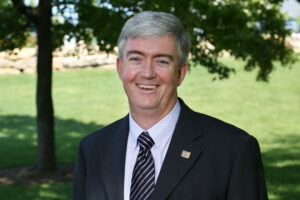Greg Hilmas named interim chair of materials science and engineering
Posted by Andrew Careaga

Dr. Gregory E. Hilmas becomes interim chair of materials science and engineering on July 1
Dr. Gregory E. Hilmas, Curators’ Distinguished Professor of ceramic engineering at Missouri University of Science and Technology, has been named interim chair of the materials science and engineering department at Missouri S&T, effective July 1.
Hilmas will replace Dr. Matthew J. O’Keefe, who has served as chair of materials science and engineering since March 2016. O’Keefe will return to full-time teaching and research within the department in the fall semester. Next January, O’Keefe will become executive director of the Haley Barbour Center for Manufacturing Excellence at the University of Mississippi.
“Matt O’Keefe and Greg Hilmas began their S&T faculty careers together nearly 20 years ago, and both have been outstanding teachers and world-class researchers,” says Dr. Richard K. Brow, interim vice provost and dean of the Missouri S&T College of Engineering and Computing. “As a friend and colleague, I am happy that Matt has this opportunity to lead the Haley Barbour Center for Manufacturing Excellence at Ole Miss, but I am very sorry to see him and his wife Laura go.”

Dr. Matthew J. O’Keefe
O’Keefe joined Missouri S&T in 1999 as an associate professor of metallurgical engineering. He was named professor of materials science and engineering in 2006 and became director of the university’s Materials Research Center (MRC) in 2007. He earned a bachelor of science degree in metallurgical engineering from S&T in 1985 and a Ph.D. in metallurgical engineering from the University of Illinois in 1993. Prior to joining Missouri S&T, O’Keefe worked for AT&T Microelectronics, AT&T Bell Laboratories and the Air Force Research Laboratory.
“As MRC director, Matt oversaw the renovation of Straumanis-James Hall, turning it into one of the finest research facilities on campus,” Brow says. “More recently, he effectively led the materials science and engineering department through the uncertainties associated with the creation and transition of the College of Engineering and Computing.”
Hilmas is known for his work in the field of ultra-high temperature ceramics — those that can withstand temperatures up to 3,000 degrees Celsius. The ceramics, similar in concept to those used in space shuttle tiles, could be employed to keep hypersonic vehicles from burning up as they cruise at extremely high altitudes over longer periods of time than shuttles or Apollo-style capsules. He is co-director of Missouri S&T’s Enabling Materials for Extreme Environments signature area.
“Greg has been one of the most productive researchers on campus, gaining international acclaim for his expertise in ceramic processing and ultra-high temperature ceramics,” Brow says. “He has also earned many outstanding teaching awards, and so epitomizes the teacher-scholar standard that the College of Engineering and Computing values. He will be a strong advocate for the MSE department and the CEC.”
Hilmas earned his bachelor’s degree in materials science and engineering from the University of Minnesota in 1986, a master’s degree in ceramic engineering from The Ohio State University in 1989 and a Ph.D. in materials science and engineering from the University of Michigan in 1993. He worked in the private sector for several years before joining Missouri S&T in 1998.
Hilmas has published more than 200 scholarly articles and has been issued 11 patents. In 2002, he received one of Research and Development Magazine’s R&D 100 awards, also known as the “Oscars of Invention.” Hilmas shared the award with colleagues from the University of Michigan and Advanced Ceramics Research Inc. for creating fibrous monolithic ceramics that are better able to resist damage than most ceramic materials.
Leave a Reply